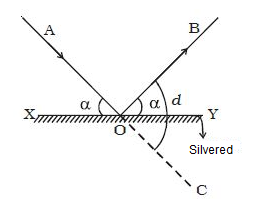
Define Glancing angle.
Answer
510.9k+ views
Hint: Here in order to answer the question we will learn about the concepts of glancing angle, relation between glancing angle and angle of incidence and how it is useful to us.
Complete step by step solution:
The glancing angle is the angle formed by the incident ray on a plane surface and the surface itself. A ray of electrons striking the crystal is an example of a glancing angle.
A glancing angle of reflection and a glance of incidence are also present.
The angle formed by a surface and a beam of particles is known as the glancing angle of reflection. It's the angle of reflection's part.
The angle formed by an incident beam and the surface is known as the glancing angle of incidence. It's the angle of incidence's part.
Consider the incident of a ray of light, AO, on a plane mirror, XY (Figure) at O. It's mirrored all the way down OB. The glancing angle with the mirror is the angle AOX made by AO with XY.

Note:
The distinction between angle of incidence and glancing angle must be understood. The angle of incidence is the angle established between the normal and the incident ray at the point of incidence. The angle between the beam and the surface, rather than the angle between the beam and the surface usually, is also more useful, i.e. 90° minus the angle of incidence, known as glancing angle.
Complete step by step solution:
The glancing angle is the angle formed by the incident ray on a plane surface and the surface itself. A ray of electrons striking the crystal is an example of a glancing angle.
A glancing angle of reflection and a glance of incidence are also present.
The angle formed by a surface and a beam of particles is known as the glancing angle of reflection. It's the angle of reflection's part.
The angle formed by an incident beam and the surface is known as the glancing angle of incidence. It's the angle of incidence's part.
Consider the incident of a ray of light, AO, on a plane mirror, XY (Figure) at O. It's mirrored all the way down OB. The glancing angle with the mirror is the angle AOX made by AO with XY.

Note:
The distinction between angle of incidence and glancing angle must be understood. The angle of incidence is the angle established between the normal and the incident ray at the point of incidence. The angle between the beam and the surface, rather than the angle between the beam and the surface usually, is also more useful, i.e. 90° minus the angle of incidence, known as glancing angle.
Recently Updated Pages
A man running at a speed 5 ms is viewed in the side class 12 physics CBSE

The number of solutions in x in 02pi for which sqrt class 12 maths CBSE

State and explain Hardy Weinbergs Principle class 12 biology CBSE

Write any two methods of preparation of phenol Give class 12 chemistry CBSE

Which of the following statements is wrong a Amnion class 12 biology CBSE

Differentiate between action potential and resting class 12 biology CBSE

Trending doubts
What are the major means of transport Explain each class 12 social science CBSE

Which are the Top 10 Largest Countries of the World?

Draw a labelled sketch of the human eye class 12 physics CBSE

Explain sex determination in humans with line diag class 12 biology CBSE

Explain sex determination in humans with the help of class 12 biology CBSE

Differentiate between homogeneous and heterogeneous class 12 chemistry CBSE




